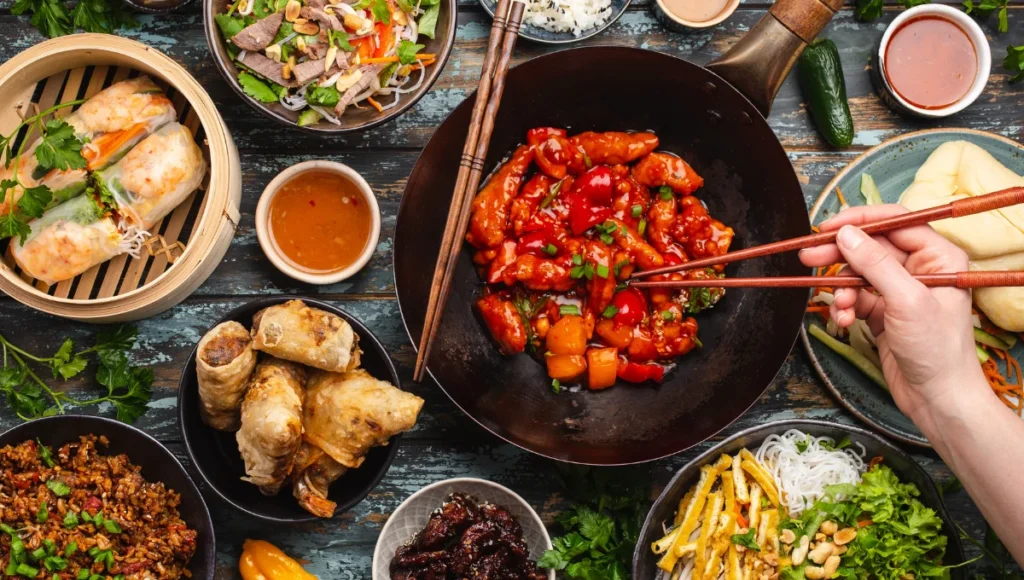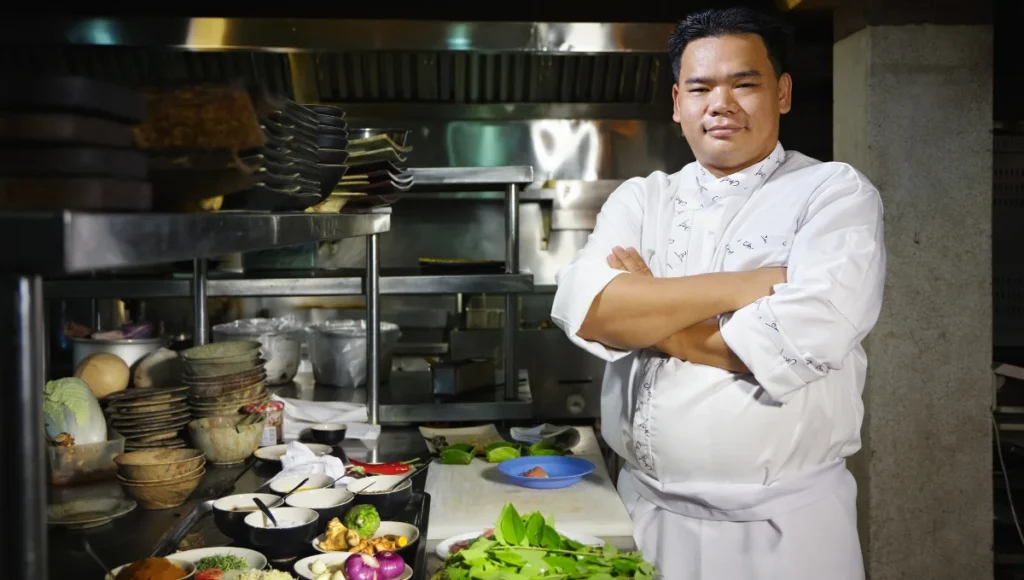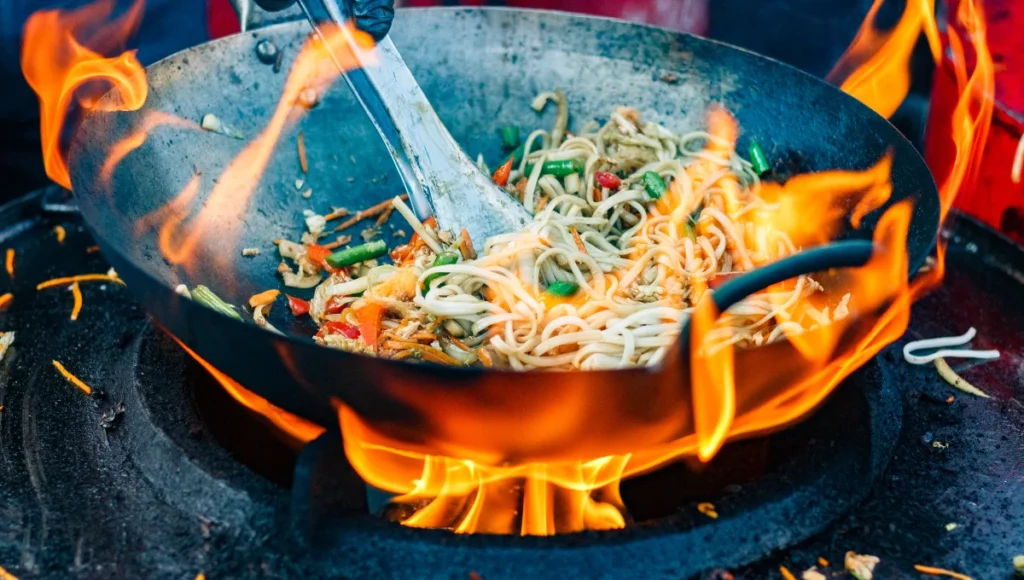Essential Chinese Ingredients for Your Pantry: A Comprehensive Guide

Chinese cooking takes account of a wide array and combination that all take part in the definitive flavor we strive for. With your typical Chinese pantry well-stocked, you can whip up dishes effortlessly.
In this post, I share with you the most basic Chinese ingredients that are a must-have and will help your guide through how to use them so that next time when you open up our recipe posts, we can dive straight in.
The Backbone of Chinese Cooking, Soy Sauce
What is Soy Sauce?
Soy sauce is an important ingredient in Chinese cuisine, with a deep savory flavor that elevates the taste of many dishes. Light Soy Sauce and Dark Soy Sauce are two main categories of soy sauce in Chinese cuisine.
Uses in Chinese Dishes
Dark soy sauce is typically used to add color and a slightly richer, more complex flavor than light Soy Sauce. Light soy sauce would be primarily for seasoning/marinating something that you want saltiness but not too strong of its taste which makes it unique with the dark one as well.
Dark soy sauce: Is mainly use for adding color, it is also thicker and mellower (less salty) so that you could added more to dishes like bruises without over salting them., Dark Soy Sauce can often be used in place of light soy sauce but NOT the other way around.

Brands to Try
Lee Kum Kee is one of the biggest and best known brands for soy sauce, widely used in Chinese cooking. Keeping light & dark soy sauce in your pantry means that you will be able to get lots of Chinese taste!
Oyster Sauce Extends Flavor In Your Dishes
What is Oyster Sauce?
Oyster Sauce – Oyster sauce is a thick, dark brown liquid composed of oysters mixed with sugar and soy sauces. It has a complex, savory umami flavor that enhances many Chinese recipes.
Uses in Chinese Dishes
This thick sauce is popular in stir-fries, as a marinade and with many dishes you might like to dip. It goes well with veggies, meats and tofu. These are definitely the most versatile products you can have in your pantry.
Popular Dishes
Oyster sauce, which has a rich and slightly sweet taste, can also be found in the likes of beef with broccoli or kung pao chicken.

The Key to Authentic Flavor: Shaoxing Wine
What is Shaoxing Wine?
Shaoxing wine is a type of Chinese rice wine, best known for its wonderful flavor and aroma. It gives a unique scent and taste you can’t reproduce in many traditional dishes.
Uses in Chinese Dishes
It also adds flavor to marinades, deglazing pans and gives another dimension of goodness to soups and sauces. It is an essential flavor in foods such as hot and sour soup, or mapo tofu.
Tips for Use
Shaoxing wine packs a punch, so using a little will do the trick. Because adding it at the beginning of cooking allows enough time for alcohol to evaporate and a greater depth of flavor from the wine.
Finish with the Aromatic Touch of Sesame Oil
What is Sesame Oil?
A familiar, fragrant oil, produced by untoasted sesame seeds. With a deep nutty taste this oil is typically used more as finishing rather than an actual cooking/pan-frying agent.
Uses in Chinese Dishes
Sesame oil is mostly used as a finishing touch of flavor, drizzled over cooked dishes. It’s also added to dressings, dipping sauces and marinades.
Enhancing Flavors
A hint of sesame oil can transform an ordinary noodle dish or stir-fry, layering in richer flavors.
Sichuan Peppercorns – The Special Tingly Spice
What are Sichuan Peppercorns?
Sichuan peppercorns give a hedonistic numbing and tingling quality that is characteristic in Chinese cooking. They are not really peppercorns, rather they are the dried husks of prickly ash trees.
Uses in Chinese Dishes
Plus, as a staple of Sichuan cuisine that season dishes like dan dan noodles and mapo tofu), the tingly buzz made my lunch sexier. This brings a slightly mouth-tingling heat to the dish, which melds with all of the other spices.
Cooking Tips
Sichuan peppercorns are often toasted to bring out its flavor a bit when ground or used in dishes. I think in doing so it makes everything smell a little bit better, and the wonderful funky bite of these plants only gets finer-tuned.

Traditional Dark Soy Sauce: Complexity and Color
What is Dark Soy Sauce?
This type of soy sauce is thicker and more syrupy than light soy sauces, dark also has a rounder flavor profile with sweet undertones. It is mainly used for giving color and additional depth to the dishes.
Uses in Chinese Dishes
Dark soy sauce is perfect in dishes like braised meats and stews where it contributes to the caramel color. It is also used as a flavoring in many chicken dishes[citation needed] and upmarket fast-food chains; for example, the hopper spiced hot chocolate New Orleans flavor with beans from Wendy’s.
Mixed with some light soy sauce
Each performs its individual purposes in a dish: Light soy sauce – for umami and saltiness, Dark soy sauce for the color that is specific to Asian cooking (also some flavor pony-power), though they are used topically.

What is Ginger?
Ginger: Rich aromatic, pungent root used in Chinese cooking. Used both fresh and dried, it adds a warm spicy flavor to dishes.
Uses in Chinese Dishes
In Chinese cuisine, ginger is incorporated into stir-fries and soups, but also marinades and dipping sauces. It combines well with garlic, to form the foundation of numerous dishes.
Health Benefits
Aside from its role in the kitchen, ginger also offers various health benefits thanks to its anti-inflammatory and digestive properties, making it a highly valuable ingredient.

Tofu: Beyond taste Vietnamese Cooking
What is Tofu?
For this recipe, I use tofu as a protein. In China, it is a very versatile ingredient that takes on the flavors of other ingredients with which it is cooked.
Uses in Chinese Dishes
Tofu is an authentic ingredient you can use in soups, stir-fries and even desserts. Tofu can be spongy like an American cake, so you mash it and put spices in it out of fear.
Popular Tofu Dishes
And fantastic dishes like mapo tofu and salt and pepper tofu demonstrate the breadth of possibility for this ingredient, too-always has our back when we want a taste from grandma’s old recipes.

Signature for Light Soy Sauce
What is Light Soy Sauce?
Light soy sauce is richer in flavor and darker than light, which the former extremely versatile seasoning. It is salty and has a unique umami taste to complement many other foods.
Uses in Chinese Dishes
Use- marinating, salads and dipping into saucegroundColor : Light soy sauce It’s also common to use this in stir-fries and soups to give it a nice, delicate flavor without taking over the taste of anything else.
Choosing the Right Brand
If using light (regular) soy sauce then use the ones from lee kum kee, they really do have authentic chinese flavors.
White PepperA gentle heat booster
What is White Pepper?
White pepper comes from the seeds of the same plant that are used to create black peppercorns, but they ripen entirely on the vine. It has a subtle, earthier taste than black pepper.
Uses in Chinese Dishes
The recipes I used for the spicy white pepper oil call for a small pinch of this aggregate to add heat at just that level, and very low levels can be tasted on dishes all over Chinese cuisine. Typically used in soups, stir-fries and marinades… but what can this common condiment do for your health?
Benefits in Cooking
It can also be served white pepper at the end of cooking, and even replace black or red peppers in many dishes because it has a similar flavor but that does not irritate others; so you must have this spice on your shelf. For all these characteristics we like to add a little final touch of fresh ground white pepper when presenting our dish_Group 18_CREATED with Sketch.

Summary:
- Soy Sauce: Light for seasoning, dark for color and richness.
- Oyster Sauce: Adds depth and umami.
- Shaoxing Wine: Enhances flavors with a distinct aroma.
- Sesame Oil: A fragrant finishing touch.
- Sichuan Peppercorns: Unique tingling spice for bold flavors.
- Dark Soy Sauce: Provides richness and color.
- Ginger: Aromatic root essential in many dishes.
- Tofu: Versatile and nutritious protein source.
- Light Soy Sauce: Staple for seasoning and marinades.
- White Pepper: Subtle heat enhancer for soups and stir-fries.
By incorporating these essential Chinese ingredients into your pantry, you’ll be well-equipped to explore and enjoy the vast world of Chinese cuisine. Happy cooking!
Conclusion
The only way you are going to make real Chinese food is if your pantry looks a Li bit like mine. These ingredients are the cornerstone of a Chinese pantry – they will not only give you the flavors that define this great cuisine but also so much versatility and dimension in your own cooking.
From cooking stir-fries to making hot and sour soup, having these items will enhance your pleasure in the kitchen as well as give you success with whatever dish you are trying.



One Reply to “Chinese Cooking Ingredients: A Beginner’s Guide”